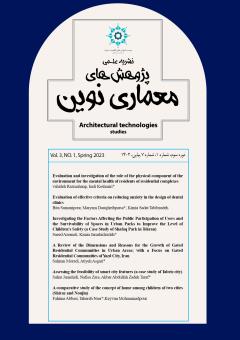A comparative study of the concept of home among children of two cities (Shiraz and Noujin)
Subject Areas : New topics in the interdisciplinary field of architecture and urban planning
Fahimeh Abbasi
1
![]() ,
Tahereh Nasr
2
*
,
Tahereh Nasr
2
*
![]() ,
Keivan Mohamadpur
3
,
Keivan Mohamadpur
3
1 - Shiraz Branch, Islamic Azad University, Shiraz, Iran.
2 - Shiraz Branch, Islamic Azad University, Shiraz, Iran.
3 - 3- M.A. in Architecture, Faculty of Art and Architecture, University of Science and Culture, Tehran, Iran.
Keywords: Applied studies, the concept of home, children, Shahrnojin, Shiraz,
Abstract :
Abstract The concept of “home” transcends its physical existence, manifesting as an intellectual image. In essence, a house is a place to live and reach peace and comfort. The term “house” encompasses two distinct aspects of meaning and concept, which are different from each other. The aspect of the house meaning is an objective reality of a place where a person resides, but the concept of the house is a mental perception. Understanding the concept of home necessitates a thorough analysis of each individual's mindset regarding their living space. The purpose of this research is a comparative assessment of the home concept among 9-10-year-old children residing in Shiraz and Nojin cities. The research methodology involves content analysis utilizing argumentative analogies along with information gathering through library and documentary studies, Persian and Latin articles, and field research. By analyzing and examining thirty samples of children's drawings from these cities, it is possible to identify the similarities and differences in their mental images of the home concept. Result of this examination and analysis is anticipated several conceptual codes can be obtained. From the summation of these conceptual codes, the home concept among the children of these cities can be found, encompassing themes such as peace, comfort, comfort, security, and prosperity.
1- اخترکاوان، مهدی؛ دیواندری، جواد؛ و اشراقی، شادی(1395). خانه از مفهوم تا معنا. چهارمین کنفرانس ملی پژوهش های کاربردی در مهندسی عمران، معماری و مدیریت شهری، تهران.
2- براتی، ناصر(1382). بازشناسی مفهوم خانه در زبان فارسی و فرهنگ ایرانی. فصلنامه فرهنگستان هنر، 8، 55-24.
3- بیلابری، سیمین؛ و البرزی، فریبا(1395). بررسی شاهکارهای ارتقاء فضای معماری مدرسه با توجه به دیدگاه دانش آموزان از نگاه نقاشیهای آن ها. نشریه انجمن علمی معماری و شهرسازی ایران، 7(11)، 57-41. doi:10.30475/isau.2017.62016
4- حسن¬زاده، سعید(1384). تئوری ذهن در کودکان ناشنوا، نشریه کودکان استثنایی. پژوهش در حیطه کودکان استثنایی16(2)، 164-143.
5- زینلیان، مریم؛ و کلانترزاده، محمد مهدی(1394). بررسی متقابل ساختار ذهنی عنصر تخیل در فضای معماری و سینما، اولین کنفرانس سالانه پژوهش های معماری، شهرسازی و مدیریت شهری،یزد.
6- سلیمانی، نبی¬اله؛ و سیف، سید مسعود(1395). ذهن به مثابه آینه طبیعت : اندیشه دکارتی در بوته نقد رورتی. جستارهای فلسفی، 12(29)، 95-132.
7- صرامی، عارفه؛ و فهیمی¬فر، اصغر(1397). تصویر، ایماژ (پی¬انگاره)و ادراک¬بصری. نشریه هنرهای تجسمی، 23(2)، 12-5.
8- طاهری، جعفر(1392). بازاندیشی مفهوم سکونت درمعماری. دوفصلنامه معماری ایرانی، 1(4)، 5-22.
9- فرهودیان، علی(1382). مکانیسم¬های اصلی نظریه ذهن. تازه¬های علوم¬شناختی، 5(3)، 88-89.
10- مهدی بیرقدار، راضیه(1382). ذهن یک محاسبه گر. تازه های علوم شناختی، 5(1)، 71- 73.
11- Barraza, L. (1999). Children's drawings about the environment. Environmental education research, 5(1), 49-66. doi:10.1080/1350462990050103
12- Cherney, I. D., Seiwert, C. S., Dickey, T. M., & Flichtbeil, J. D. (2006). Children’s drawings: A mirror to their minds. Educational psychology, 26(1), 127-142. doi:10.1080/01443410500344167
13- Cooper, C. (1974). The house as symbol of the self. The people, place, and space reader, 168-172.
14- Lynch, K. (1960). The image of the city. MIT Press.
15- Rapoport, A. (1969). House Form and Culture. Englewood Cliffs, NJ: Prentice-Hall.
16- Tinnin, L. (1990). Biological Processes in Nonverbal-Communication and Their Role in the Making and Interpretation of Art. American Journal of Art Therapy, 29(1), 9-13.
17- Tognoli, J. (1987). Residential Environments. In D. Stokols, & I. Altman (Eds.), Handbook of Environmental Psychology, 1, 655-690.
18- Gunindi, Y. (2012). Environment in My Point of View: Analysis of the Perceptions of Environment of the Children Attending to Kindergarten through the Pictures They Draw. Social and Behavioral Science, (55), 594- 603. doi:10.1016/j.sbspro.2012.09.541
19- Low, S.M., Altman, I. (1992). Place Attachment. In: Altman, I., Low, S.M. (eds) Place Attachment. Human Behavior and Environment, vol 12. https://doi.org/10.1007/978-1-4684-8753-4_1
20- Appleyard, D. (1979). The environment as a social symbol. Ekistics, 46(278), 272–281.
21- Alloa, E. (2005). Bare exteriority: Philosophy of the image and the image of philosophy in Martin Heidegger and Maurice Blanchot. Colloquy, (10), 69-82.
22- Ellaway, A., & Macintyre, S. (2004). You are where you live. Evidence shows that where we live has a significant impact on our mental health. Mental Health Today (Brighton, England), 33-35.

